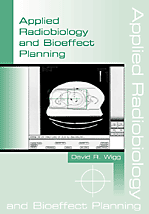
Applied Radiobiology and Bioeffect Planning
Author: David WiggISBN: 9781930524057 ISBN10: 1930524056
Published: 2001 | 486 | Softcover
Price: $ 79.95 was 180.00
Physics in Medicine and Biology | January 2002
HTML>
"Working on the basis that treatment planning algorithms will in future need to be more biologically based, the author of this book has spent several years researching this area and has developed an interactive bioeffect planning system at his own Centre in Adelaide. A clinical oncologist by profession, Dr. Wigg discusses the clinical and physiological considerations which determine biological response to radiation but at the same time has not held back from using copious mathematics to put the ideas into a quantitative context. Overall there is a heavy reliance on elaborate equations and the book reads very much as though it has been prepared for physicists.
"The text is written in a generally clear style and, along with the extensive literature and parameter review, the work comes across as being one of considerable scholarship. Some readers might quibble about the order in which the more basic ideas are introduced but, for those patient enough to seek out the details they are looking for, the book will be found useful. One feature is that it does not simply discuss the various models used to quantify fractionation and dose-rate effects, but also examines their parameter sensitivity and how they might need to be 'tweaked' in order for them to better fit the clinical data. Indeed, the author's emphasis on the need for clinical credibility before models can be used widely in bioeffect planning comes across in many places. The chapters discussing the radiobiology of arteriovenous malformations (AVMs), combined radiotherapy and chemotherapy, radiation volume effects and radiobiological parameter values stand out as being particularly useful.
"Unfortunately, the book is quite badly let down by the graphs; for one reason or another many have little or no value. In nearly all of the figures the formula used to develop the data points is printed in its entirety next to the graph. Whilst some may consider this laudable, the inclusion of (often complex) formulae in the axis captions requires a lot of space, as a result of which many of the graphs are excessively contracted in one direction, rendering them of next to no value. A further irritation is that many of the axis scales extend far beyond the range of the plotted data, an elementary point which should have been picked up by the publisher. Finally, some of the graphs purporting to demonstrate the different predictions of alternative models appear to be identical while others (e.g. those on pages 106 and 107) contain no data points at all. The likely explanation for these shortcomings is that the graphs are taken directly from laptop computers used in teaching workshops to illustrate how biological effects are altered when the assumed models (or parameters) are varied. In an interactive forum this approach probably works well but the inclusion of the unedited graphs as static entities within the book makes them much less effective.
"Despite these criticisms the author has produced something that contains enough solid discussion on bioeffect planning to warrant a place in departments with an interest in this field. It does fall short of being an ideal teaching text and those approaching this subject from a cold-start may find that they need to additionally refer to some of the referenced papers in order to glean the most benefit from the book. However, with the subject still in an embryonic stage it will be some time before things become set in stone and this book does manage to provide the most comprehensive overview of models and data currently available."
R.G. Dale
Physics in Medicine and Biology
January 2002
